Is translation accuracy something you’re unsure how to handle for your business? Choosing the right method can make all the difference.
Using machine translation only or choosing human editing of automated translations can help you save time and keep your brand’s message clear.
This guide will help you understand when to use each method. We’ll talk about why quality is important and give you simple tips to avoid translation mistakes. By the end, you’ll know how to make your translations work better for your business!
What is Machine Translation and When Is It Enough?
Machine translation, often called MT, uses computer software to translate text from one language to another. It’s quick and cost-effective, making it a popular choice for many businesses.
Let’s say you run an online store with thousands of products. You could use machine translation to quickly update your product descriptions in several languages, allowing you to expand into new markets without delay. This approach keeps your costs low and speeds up the process.
When should you use machine translation?
It’s perfect for simple content, like product descriptions, where speed matters more than perfect style. It also works well for your internal documents or emails, where the main goal is to quickly understand the content, not to impress with perfect language.
What are the benefits of Machine Translation?
One of the biggest benefits of machine translation is its rapid turnaround. You can translate large amounts of text almost instantly, which is great when you’re short on time. Plus, because its performed by a computer only, it helps keep your costs down, especially if you regularly need to translate lots of material.
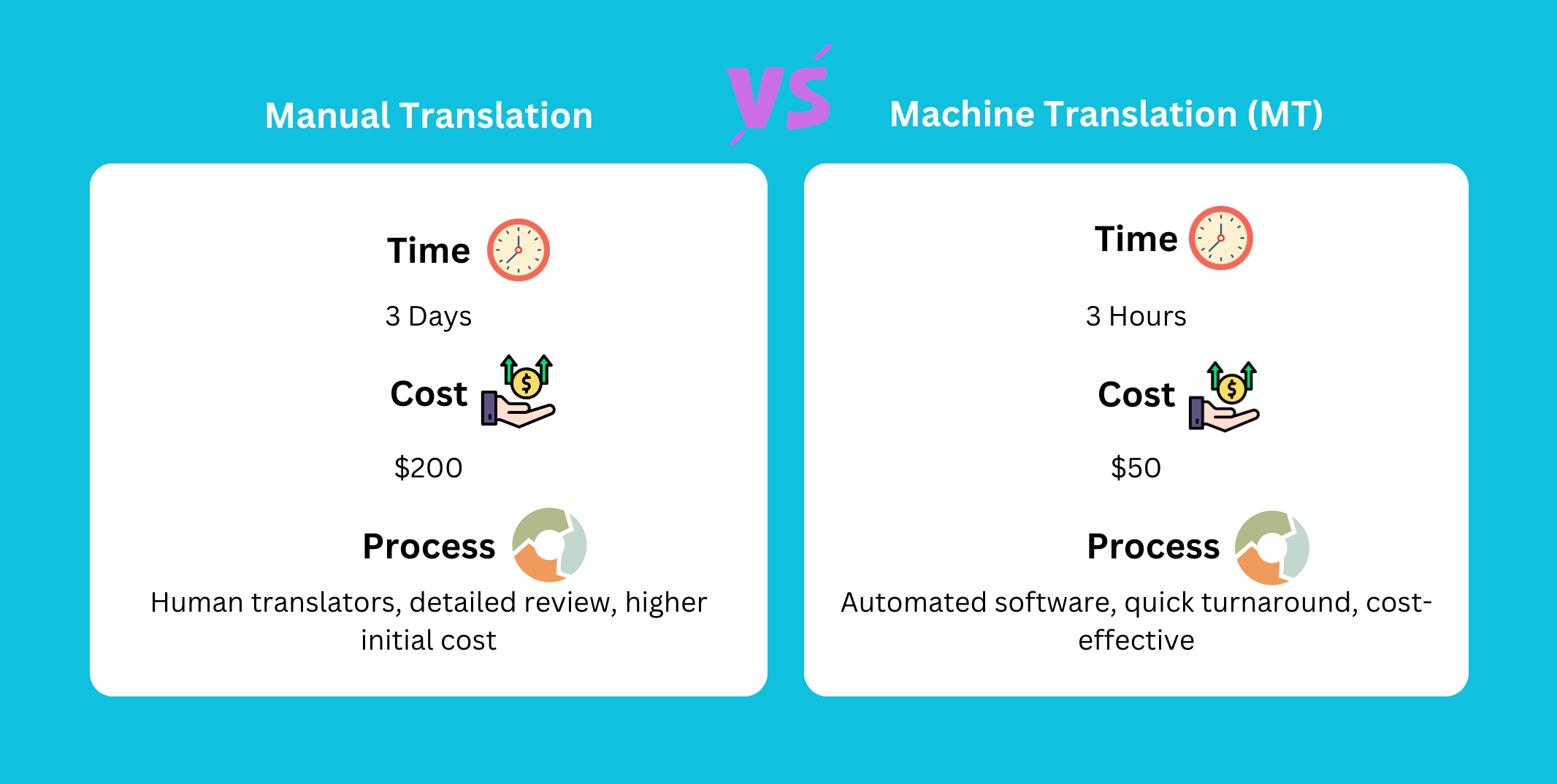
More than 70% of language professionals in Europe use machine translation, showing how common it has become. The global machine translation market was worth $650 million in 2020 and is expected to grow to $3 billion by 2027, highlighting its increasing importance (Source: Global Market Insights).
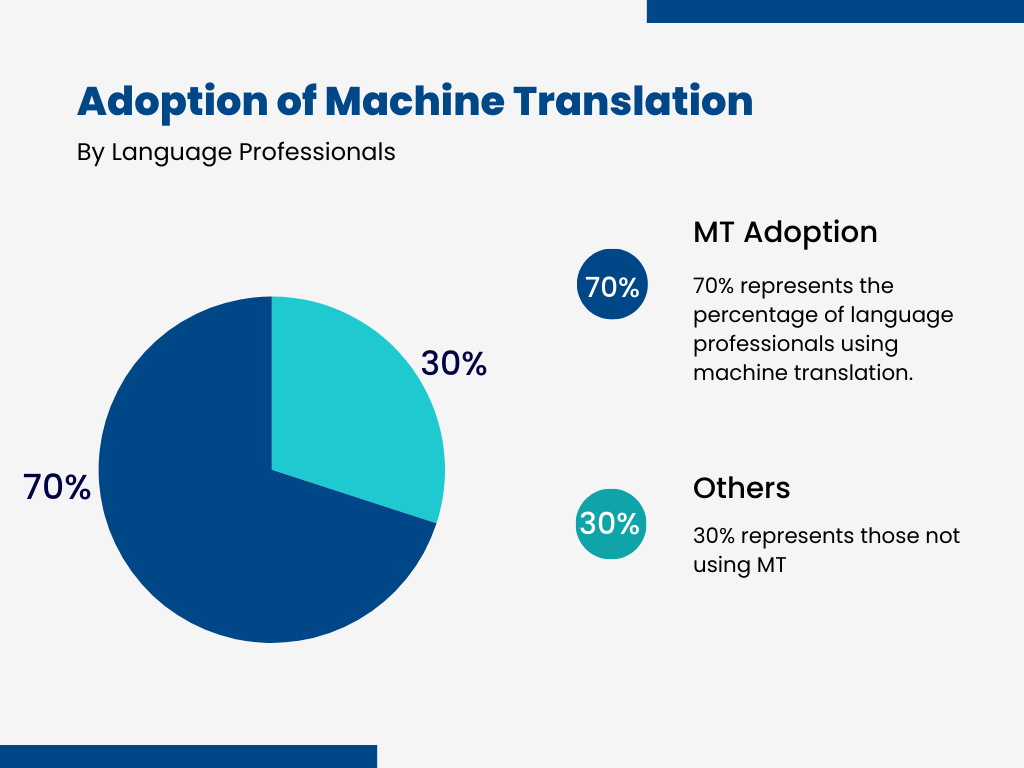
When Should You Opt for Human Post-editing?
Human post-editing is the step where a skilled person reviews and improves the machine-generated translation. This process helps make sure the translation is clear, accurate, and suitable for your audience.
For instance, you might be launching a marketing campaign in a new country. You would want the slogans and promotional materials to capture the local culture and resonate with your audience. Human post-editing can make sure your message is both engaging and culturally appropriate. It can also ensure translation accuracy.
What are the most common content types that need human post-editing?
To list a few:
- Marketing materials: Ensures messages are persuasive and culturally relevant.
- Legal Documents: Requires precise wording and understanding of legal jargon. See how this full-service law firm ALN Africa translates their legal documents in this case study.
- Creative Content: Like literature or film scripts, which need to preserve artistic elements.
So, what are the benefits of Human Post-editing? Let’s look at some of them.
Improved translation quality
A human translator can catch errors and awkward phrases that a machine might miss.
For instance:

Translation Accuracy and Cultural Relevance
Humans can adjust the translation to fit the cultural context, making sure it sounds natural to native speakers.
For example:
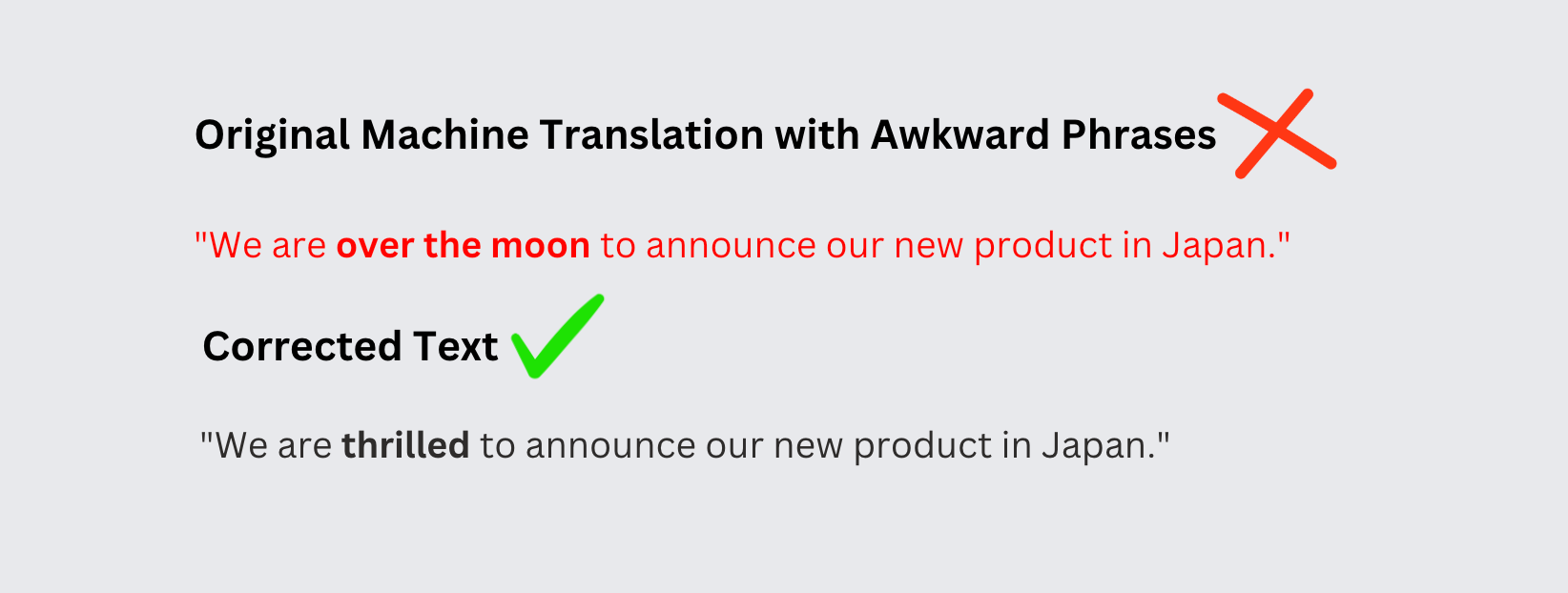
Consistent Tone and Style
Human post-editing helps maintain your brand’s voice and makes sure that there is consistency across all your content.
For example:
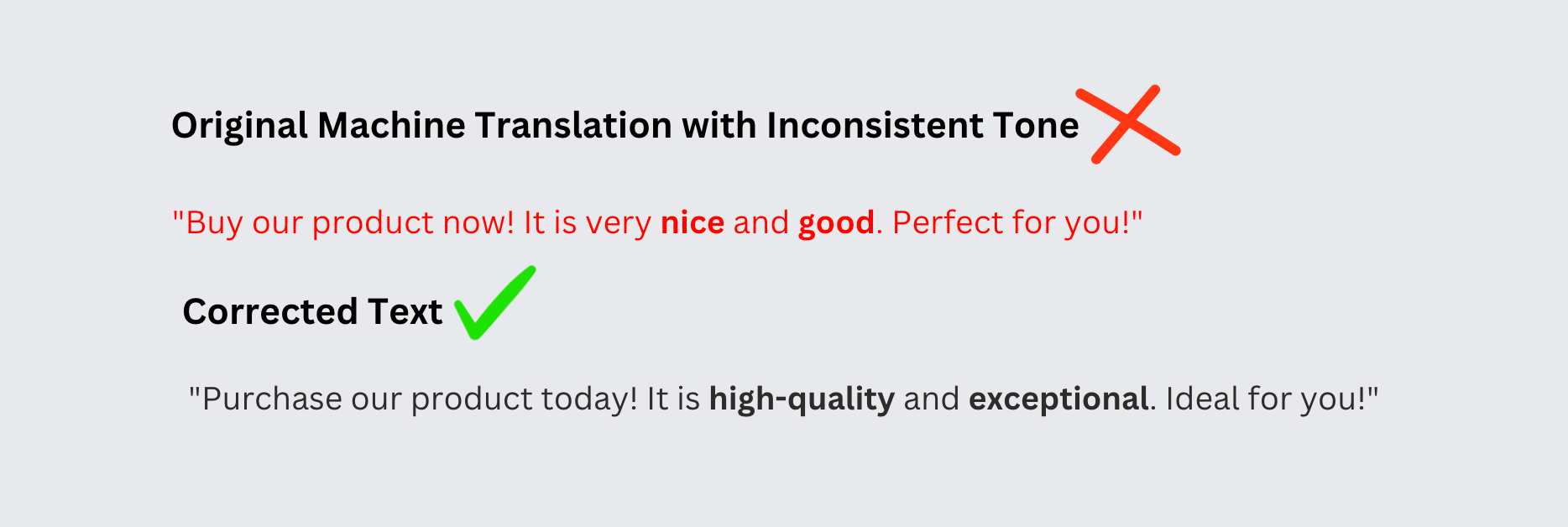
How Do Costs Compare Between Machine and Human-Assisted Translations?
Understanding costs is important when considering translation. Machine Translation (MT) is often cheaper upfront. It allows businesses like yours to quickly translate large amounts of text without spending much money.
But if you choose human-assisted translation or human post-editing, you’ll most likely get higher quality and accuracy. This is important for content where details matter, like marketing materials or legal documents.
While it might cost more initially, investing in human post-editing can prevent misunderstandings that could be expensive later.
Another thing you should note is this:
TextUnited, a supervised AI translation platform, is your go-to solution for benefiting from both machine—and human-assisted translations.
Why?
Because TextUnited supports more advanced automated translations which include features like translation memory, terminology management, and automated quality estimation and involves human translators for improving automated translations. The improvements are kept in TextUnited system and reused in future translations.
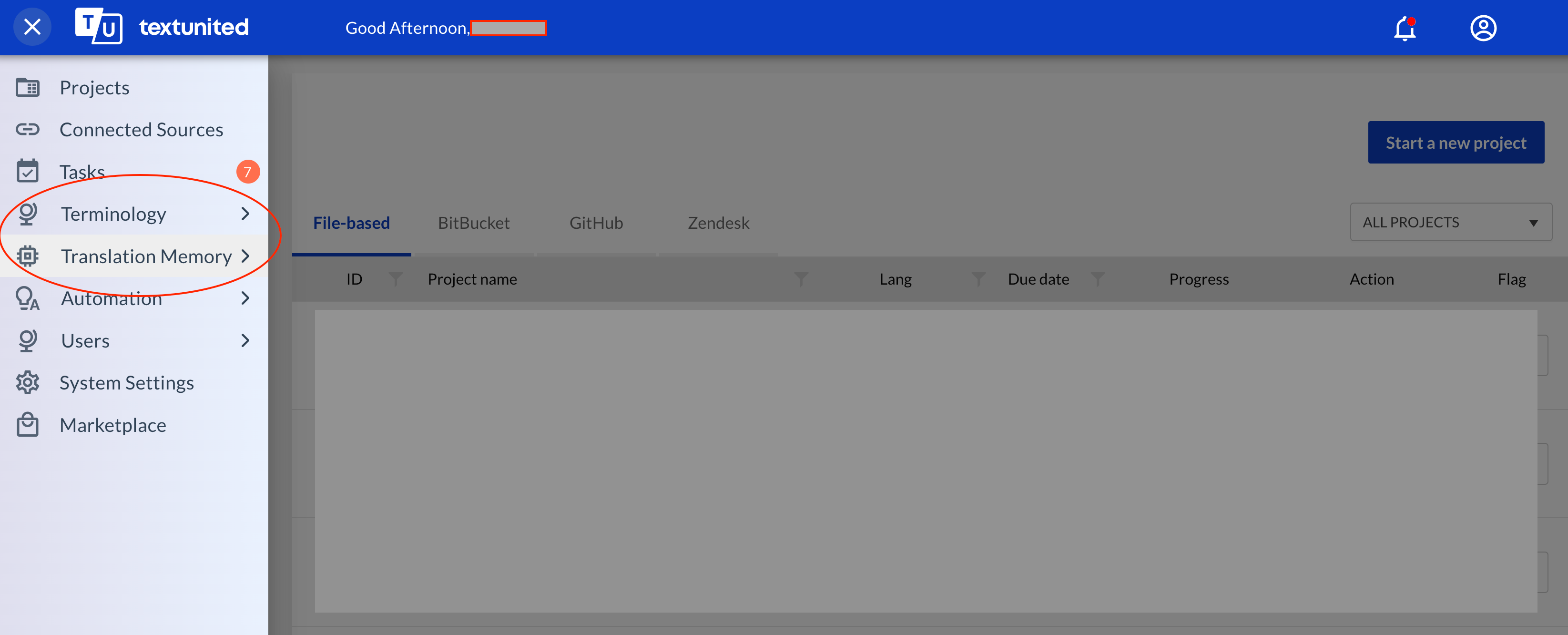
This means that your costs go down as you continue translating more content, making the initial investment in human post-editing even more worthwhile.
As you translate more content, your costs can decrease, making human post-editing a valuable investment for your brand. While machine translation offers lower initial costs, automated translation with human input provides the quality needed to protect and improve your brand’s image and increase the quality of your multilingual communication capabilities. Balancing these options based on your needs and budget helps you make the best decision.
Which Is Faster: Machine Translation or Human Post-editing?
When it comes to speed, machine translation (MT) is the clear winner. It can translate large amounts of text almost instantly. This speed is a huge advantage for businesses like yours that need quick results, like when updating product listings or responding to customer inquiries.
While MT is fast, it may not always provide the level of translation accuracy that you need for some types of content. It’s at this point that human post-editing, comes in to ensure translation accuracy and deliver the highest translation quality.
Human post-editing takes longer because it involves a translator reviewing and refining the text to ensure clarity and translation accuracy. However, the translation process is expedited by automated quality evaluations that highlight potential issues for the translators, helping them to make corrections more quickly.
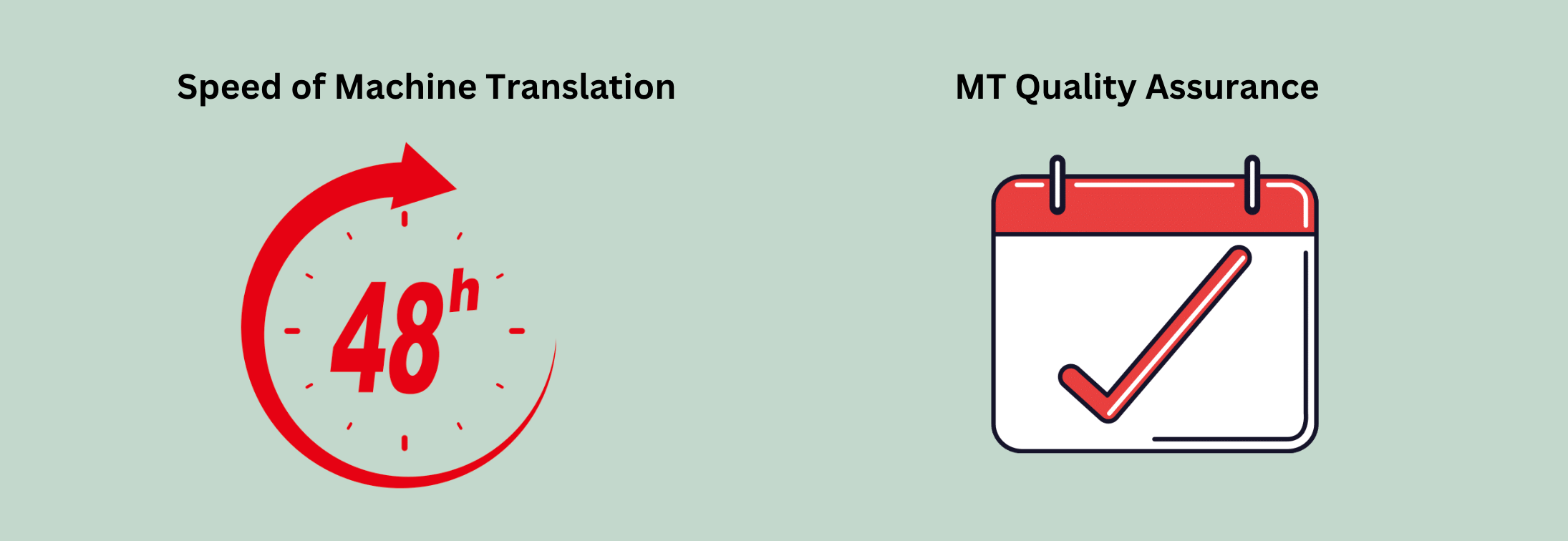
Translation Process and Turnaround Times
Machine translation gives you immediate results, making it ideal for urgent tasks. On the other hand, machine and automated translation with post-editing (MTPE) takes more time but delivers higher quality. For example, while MT might translate a document in seconds, MTPE might take a few hours or a day, depending on the complexity and length of the text.
Choosing Based on Urgency and Content Type
If you need a quick translation and the content is straightforward, like internal emails, MT might be enough. However, for content where accuracy and tone are important, investing extra time in human post-editing is worth it. Balancing the need for speed with the need for quality is key to making the right choice.
Who Prefers Human Post-editing and Why?
Different industries have different translation needs, which affects whether they choose machine translation (MT) with or without human post-editing or fully human translation.
Look at this table:
Industry |
Prefers |
Reason |
Example |
| E-commerce | Machine Translation | Needs to translate many product descriptions quickly and affordably. | Fast fashion retailers use MT for rapid product listing updates. |
| Tech Startups | Machine Translation | Requires fast internal communication across global teams. | Startups use MT for quick updates and documentation sharing. |
| Legal and Financial Services | Human Post-editing | Requires high accuracy and compliance with industry standards. | Law firms use human post-editing to ensure accurate contract translations. |
| Marketing and Advertising | Human Post-editing | Needs culturally appropriate translations to maintain brand voice and connect emotionally. | Global brands use human post-editing to adapt advertising campaigns for countries. |
Let’s see why these choices are made.
- Quality and Accuracy: Industries that handle sensitive or complex information often choose human post-editing to avoid mistakes and meet industry standards.
- Cultural Understanding: Areas like marketing need translations that fit the cultural context. Human translators can adapt messages to be both effective and respectful of cultural differences.
In the end, the choice between MT and human post-editing depends on how much you value speed, cost, and the need for precise and culturally aware communication. Each industry makes this choice based on their specific needs and customer expectations.
How to Choose the Right Translation Approach
Choosing the right translation approach can make a big difference in how well your message is understood.
See this checklist that can help you make your decision:
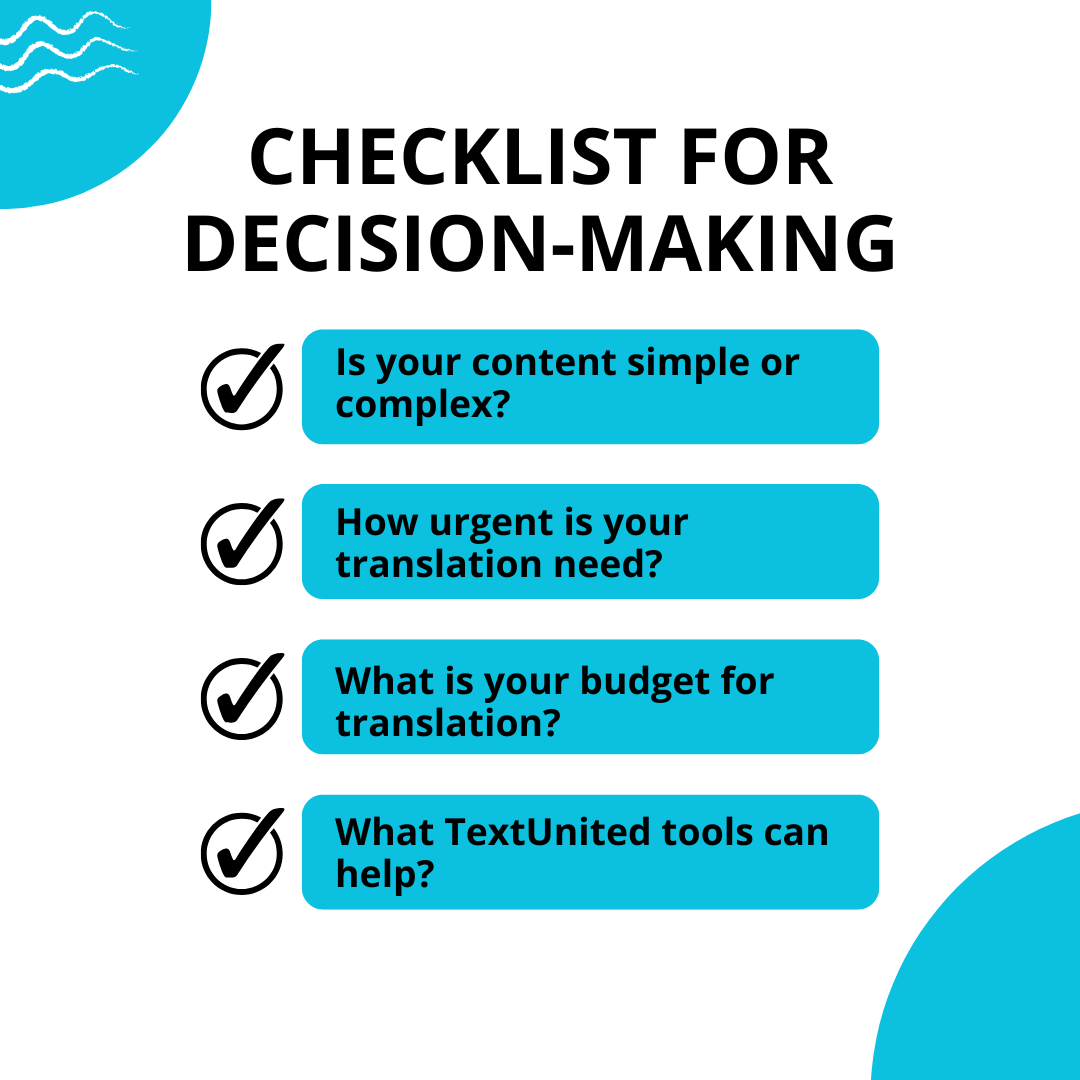
Here’s a simple step-by-step guide to help you decide whether to use machine translation (MT) or human post-editing.
Step 1: Determine Your Content Type
- Repetitive or Simple Content: If your content is repetitive or straightforward, like product descriptions or basic emails, machine translation might be enough.
- Complex or Creative Content: For content that is complex or needs a creative touch, like legal documents or marketing materials, consider human post-editing.
Step 2: Consider Urgency
- Immediate Needs: If you need a translation quickly, MT is your best bet. It’s fast and can handle large volumes in minutes.
- Flexible Timeline: If you have more time and quality is crucial, human post-editing is worth considering. It takes longer but ensures a higher level of accuracy and clarity.
Step 3: Assess Your Budget
- Limited Budget: MT is more cost-effective for bulk translations and can be a good choice if you’re working within a tight budget.
- Quality Investment: If you can invest more for better quality, human post-editing can provide the accuracy and cultural sensitivity needed.
Final Thoughts on Achieving Translation Accuracy
Choosing the right translation method is important for making sure your message is clear. You can use machine translation for quick and simple tasks, or opt for human post-editing for more detailed and creative content. Each option offers different benefits, and understanding these can help you make good choices.
To make the best decision, think carefully about your translation process and consider using TextUnited platform. The platform allows you to choose any of the options we discussed in this article, making it ideal for more complex business needs and different types of content and requirements. TextUnited tools help ensure high-quality translations by keeping your content consistent.
If you have questions or need more help, feel free to contact us. We’re here to assist you. With TextUnited, making informed translation decisions has never been easier!

